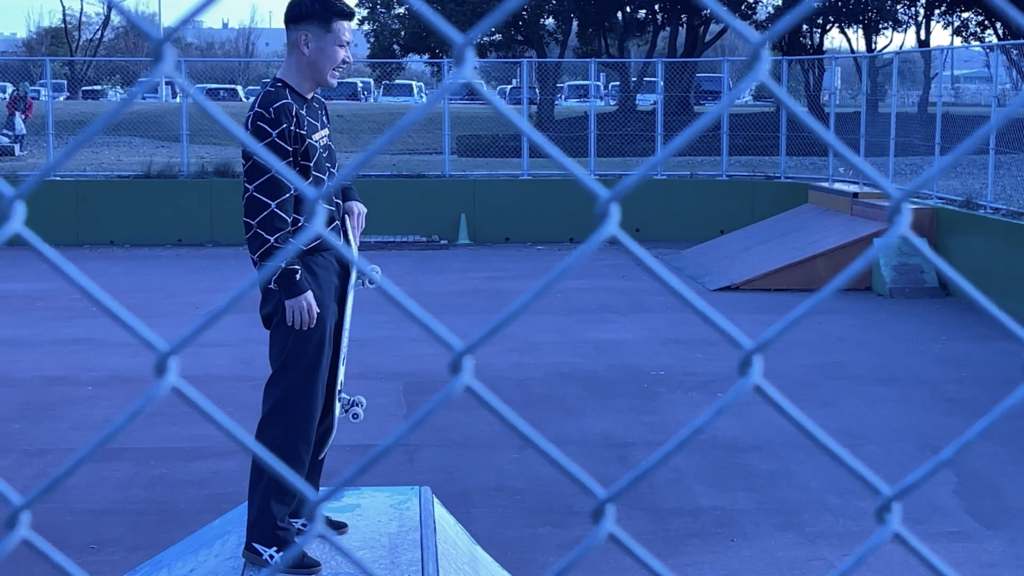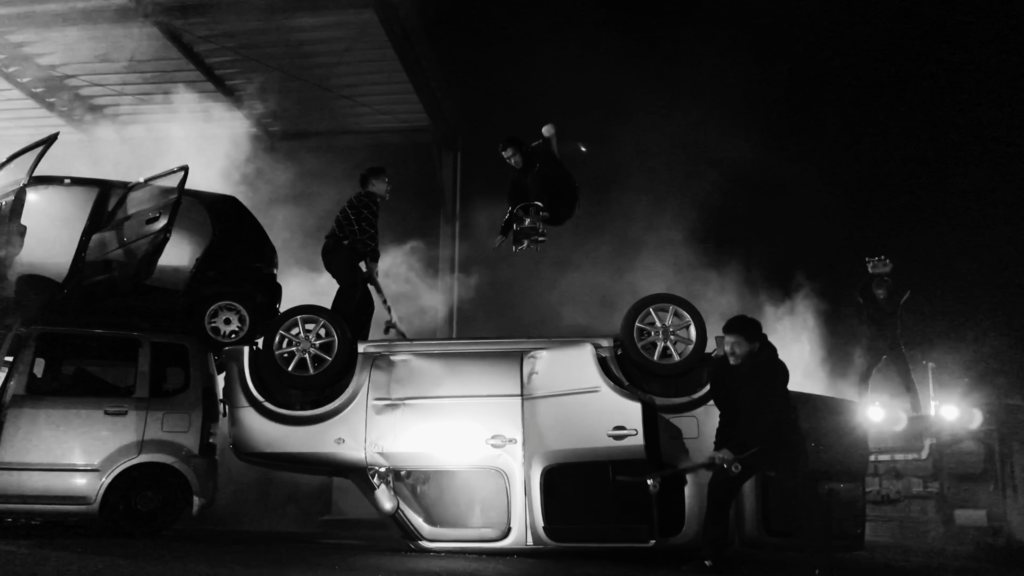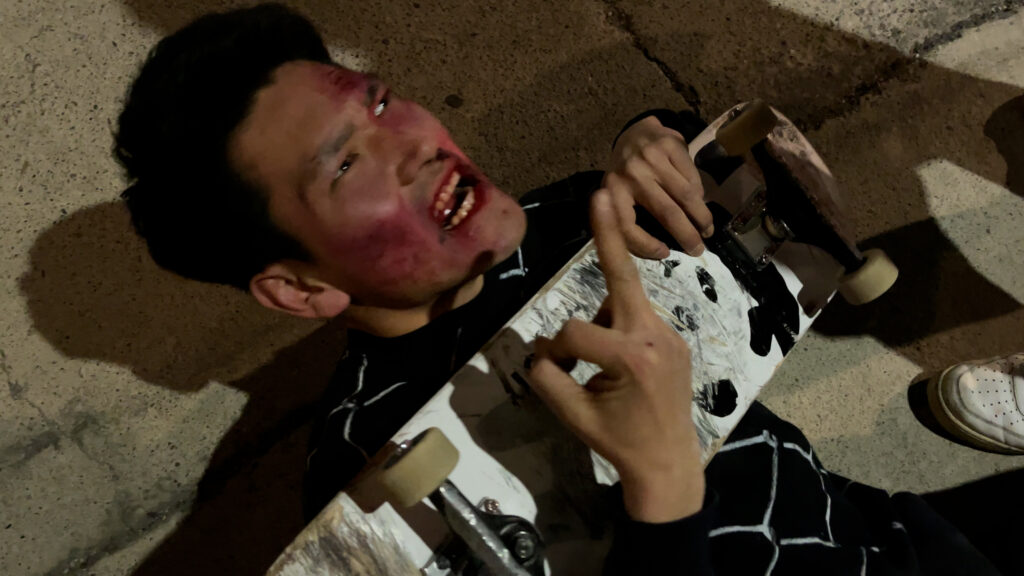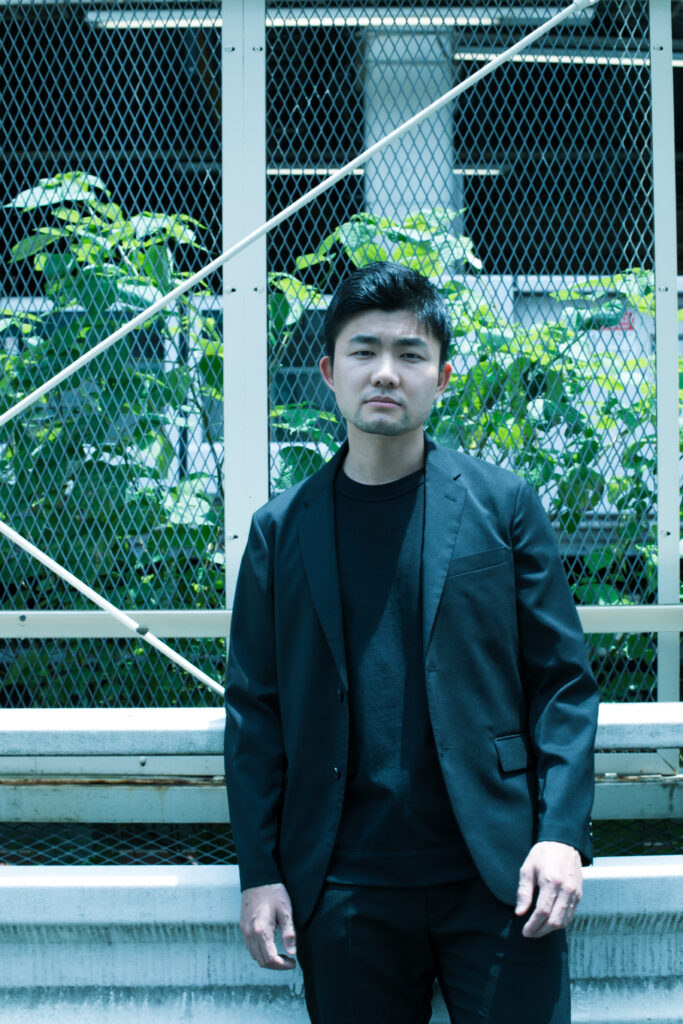Director Yuki Kobayashi made his commercial movie debut with “Zeiin Shikei (Death Row Family),” and has since garnered a great deal of attention. In his latest movie, “Wings of The Abyss,” which was completely self-produced from filming to distribution, he turned his camera on skaters who were being excluded from society. Kobayashi had never known any skaters before, so what drew him to skateboarding? What kind of filming method did he apply to feature non-professional casts? Writer Minori Suzuki talks to the director.
After studying graphic design at a vocational school, Yuki Kobayashi began making independent movies with a single-lens reflex camera on the recommendation of his boss at the design office where he was working. Soon after, in 2014, “Super Tandem” was selected for the PFF Awards, “Night Safari” won the Kanazawa Film Festival Award and was selected for the TAMA NEW WAVE Un Certain Regard section. In 2017, he made his commercial movie debut with “Zeiin Shikei (Death Row Family)” starring Shotaro Mamiya. Since then, he has continued to direct drama series including “GIVER: The Giver of Vengeance” (2018), “Sujibori” (2019), and “Home Room” (2020), both for terrestrial digital channels and on-demand contents distribution services.
On the recommendation of writer Michiyo Nishimori, I watched his TV drama “Scams” (2019), which was selected as the winner of the 57th Galaxy Awards in the TV category. Based on the book “Roujin Gui (Old Man Eaters)” (written by Daisuke Suzuki, Chikuma Shinsho), it is a drama about a young man who graduates from university and starts working for a major company, but is soon laid off due to the Lehman Shock and becomes involved in bank transfer scams targeting the elderly. The story of a young who is driven by a desperate situation where he has no other job opportunities, repayment of education loans, and a father who is hospitalized for a serious illness, to commit crimes, is a sensitive reflection of the “atmosphere” prevailing in society as seen in various news reports. This drama is characterized by the excessive but quiet depiction of violence and the thrilling process of scams done in a team that is shown through the combination of wide shots, shots from carefully set angles, and the tension-filled long takes. A fast-paced viewing experience each episode creates enabled me to watch the whole series without a break. In the second half of 2020, I was hooked on Kobayashi’s films.
Then I heard that he was going to make a film about skateboarding, “Wings of The Abyss,” independently. One day, Jin (Umemoto Jingi), a company employee with a poor sales performance who has been making mistakes, meets a skater Ikeda (Ikeda Kota). Jin enjoys skateboarding with Ikeda and his friends, but he encounters a group of skater-blockers on the streets and in the park. The idea of making a film about skaters came from Instagram videos that Kobayashi happened to see.
“I’m not sure if it’s because of the Corona pandemic or because of me, but I had a lot of free time on my hands, and I was spending time watching a lot of trouble videos on Instagram and TikTok. Then I was struck by a video that popped up as a recommendation on Instagram, and I was like, “This is it! I felt as if I had been hit by an electric shock. It was a video of a skater sliding down the stairs between buildings, and camera then captures an old man (by the window of the building) throwing a planter he was holding, and then the camera was turned to the skater again to capture the planter hitting his head and falling down. The video continues, and the dirt-covered skater skates a few more times, succeeding the next time. I like people who are, even if they get beaten up, stand up again naturally and never give up.
Kobayashi once said, ‘I like films with rebellious people in them,’ and his own films also show the violence that results from the oppression reproduced in a male-dominated vertical society, and the rebellion against it. His awareness of the problematic power structure that creates “bad guys” and leads to group violence against them portrayed in his earlier movies about bike gangs “Koko no Toboe (Howling Alone)” and “Gyakuto,” is also evident in ” Wings of The Abyss,” which depicts the conflict between skaters and those who do not listen to them and see them as enemies.
The project began with a piece of paper that reads, “People who have lost their place and are marginalized.”
Kobayashi did not know any skaters before making this film, so how did he gather the actors? He says that his filmmaking was further developed through conversations with Umemoto, who had started his career as an actor after appearing in “Koko no Toboe (Howling Alone).”
‘When I told Umemoto that I wanted to make a skateboarding movie, he replied,”I’ve been waiting for that.” I was like, “Then you should have told me earlier, because I’m struggling to find the subject matter (laughs).” I was also struck by a picture of a skater jumping in front of a car that was on fire and flipped over, so I wrote something on Twitter like, “I want to do this (with that picture attached), so can any skater make a movie with me?” I forgot that I wrote that while I was taking a nap or a half-body bath, and then Umemoto-kun told me, “Yuki-kun, that’s great, Kota Ikeda commented on your post,” and “He’s my favorite skater.” When I looked up Ikeda-san, I found a horrifying article about him talking intensively about Adachi Ward in Tokyo. I thought he was interesting and scary at the same time, but I also understood why Umemoto-kun liked him. He’s a person who has doubts about the sense of stagnation. So I sent a very polite direct message to Mr. Ikeda after reading something like “How to Write a Nice to Meet You Email” (laughs). ‘
Questioning the sense of stagnation. It reminds me of “Sujibori,” in which the generation of excessive violence from closed homosocial relationships is depicted in the form of Yakuza entertainment, and its story and genre boldly turns to “somewhere other than here” towards the end.
‘Ikeda-san replied, “Let’s meet and talk,” and I met with him, Ikeda-san’s friend actor Gota Watabe, and Umemoto-kun. I gave him a sheet of paper that contains the plot of the movie: That is skaters feeling uncomfortable, losing a place to stay and leaving after being told that they shouldn’t be here because they are annoying and wrong. We hit it off as we were discussing these complaints.’
I remembered that I was attracted to Kobayashi’s work because I was fed up with the film and media industry, which seemed to be corroded with various problems I had seen and heard about, such as power harassment, non-regular labor, and economic disparity, and it seemed that he was making movie that addresses the same kind of problem.
Shooting techniques to capture skaters as they are
The scenario was created by listening to the stories of the skaters introduced by Ikeda. For example, in response to some skater’s explanation about the technique of putting the skateboard’s wheels on a bench, I thought about how I could use it to create the scene of trouble between skaters and claimers (Kobayashi has previously talked about the technique of creating scenarios for each topic he heard about in independent filmmaking).
‘In the past, I’ve asked delinquents, bikers, and other people who have nothing to do with acting to act for my independent movies. In these movies, I just explained that I would like this and that to happen because a script would impose limits on their performances. Since it was impossible to reproduce the same acting situation, I could not do the camera blocking, so I was only allowed to film each scene in one long take. What I really like is filming where the meaning in the script and the structure of the scene in the image, the mechanisms and devices, make an appropriate sense. I was told that if I made my commercial movie debut, it would be stressful because I wouldn’t be able to do what I really wanted, and that I would struggle with the limitations, but in fact independent films have much more restrictions. I choose the technique depending on the content of the film, so it may look like a compromise, but for “Naraku no Hane,” there is no other choice but this one.’
Like the film “Hedorova” (2017), “Wings of The Abyss” was shot on iPhones, and uses a technique used in variety shows called “one-camera shows” to take advantage of the single camera filming. This technique was used in the scene where the main character Jin, played by Umemoto, is at a party with his friends.
‘One-camera shows are really interesting because you can film what’s happening in front of you and critique it at the same time, making an image while evaluating it. In commercial movies, we make prior arrangements with each department to say, ‘This is how it’s going to work,’ and even if something happens by accident on the set, we have no choice but missing the shot, which is a shame. I think it’s great because it’s for the betterment of the working environment, but my ideal is for the camera to be able to follow along what is happening. I tried it this time, but I was satisfied to a certain extent, so I edited the video boldly to make it look more fast-paced (laughs).’
Although the length of the scene is shortened, I think the tension and vividness of the long take remain firmly on the scene. And more importantly, the skateboarding scene has a sense of floating and vigor.
‘I was struck by the wildness of the skate video I saw before filming. I had been at home during Corona pandemic for a long time, and I had been feeling cramped, so I felt that freedom more than ever. The human body is moving without any cover when one is riding skateboard. It’s really interesting as an image, isn’t it? You stand sideways on the board while riding it, which looks quite peculiar. So I thought, “If I can convey this dynamism, I don’t care how many cinematic technical rules I have to break.” Also, at first I was thinking of getting actors who could ride skateboards, but because the story itself was inspired by meeting Kota Ikeda, I thought it was necessary to have real skaters in the movie.’
Water-spraying claimers and the elimination art in the city
The first half of the movie shows people complaining about skaters. What strikes the viewers most is a person who claims that her memory-filled bench was destroyed by the skaters.
‘The complainer is a lady with a stage name Uso-tsuki-san (Liar), and when she was playing the role, the skater started laughing a little cynically. I stopped filming because that made me feel disgusted and made me want to support this claimer lady because she was boldly standing up against four skaters dressed in black by herself. So I told skaters, “That kind of attitude makes me want to change the story to show you (skaters) as the enemy.” Even a person who is desperately trying to insist something in a loud voice also has her own reason to do so.’
Those who are dissatisfied with the skaters have a variety of backgrounds and status. Whether it’s skaters or complainers, of course there are some actions that are simply unacceptable, and we need to be careful about the power structure of each individual case, but we can’t deny that the people who feel annoyed can also express their frustration and anger.
‘I heard that some people throw sand and others throw bait to attract pigeons because they want to get rid of the skaters because they would ruin the scenery. Watanabe-san said that there was a person who threw pieces of onion at him(laughs). Cleverer people spray water because it can decay the skateboard that is made of wood and iron. Water is a way to slowly break the heart of skater. I had to edit out these stories because they need a lot of explanations, which does not work very well in the movie. But they are interesting. Also, there are streets on which rubber boards put at different intervals to prevent people from riding skateboards, but the scenery is much worse. They are really disgusting.’
Where there is “exclusion,” “they” appear.
As a result of public policies, certain people are not allowed to even “be” in public spaces and are excluded. This reminds me of an example of Miyashita Park. After the eviction of the rough sleepers from the park in Shibuya Ward, it turned into a commercial facility. I felt that this issue of urban cleansing (gentrification) shares a common ground with the story of “Wings of The Abyss” in which the skaters can no longer be there.
‘This movie is not only about issues related to the skaters. Rather I wanted to raise anger and questions about things like “you’re wrong, you’re unnecessary, you should go away” in various situations.’
In the middle of the film, the skaters are forced to stay at the skater park after they are finally devastated by the strong assertion of the complainer played by Uso-tsukisan. From there, the story transforms further, and the main character, Jin, is excluded from society. I hope all of you who are reading this article will witness what symbolizes the desperate situation: an unpleasant image of “a place that does not belong to this world” created by the director,-Kobayashi’s aesthetical decision of “what not to show” is brilliantly made with subtracting technique he learned from “Sujibori”-and what happens to the skaters in the “abyss”.
‘The irony is that as the roads become filled with more and more angular objects and new buildings come up, there are more and more places for skaters to play. I hope that people who watched the movie and fed up with the situation will think, “Oh, there must be someone coming here who is going to destroy it” when they see something being built in the city. They will come! They’ll sneak like monsters in the place where there are people who are having fun in getting rid of something or there is a sign that says “Don’t skateboard!” to riot in the middle of the night! (laughs).’
Yuki Kobayashi
Born in Shizuoka Prefecture on September 30, 1990. While working at a design company, he made independent movies “TOGA” and “Zettai Anzen Cutter Knife (Absolutely Safe Cutter Knife)” and posted them on video sites. He won the Grand Prix in the Off-Theater Competition section of the Yubari International Fantastic Film Festival 2016 for “Koko no Toboe (Howling Alone)”. In 2017, he made his commercial movie debut with “Death Row Family”.
Twitter:@yuchimuchan
Instagram:@violencejack_film
Photography Mayumi Hosokura
Edit Sogo Hiraiwa
Translation Shinichiro Sato







